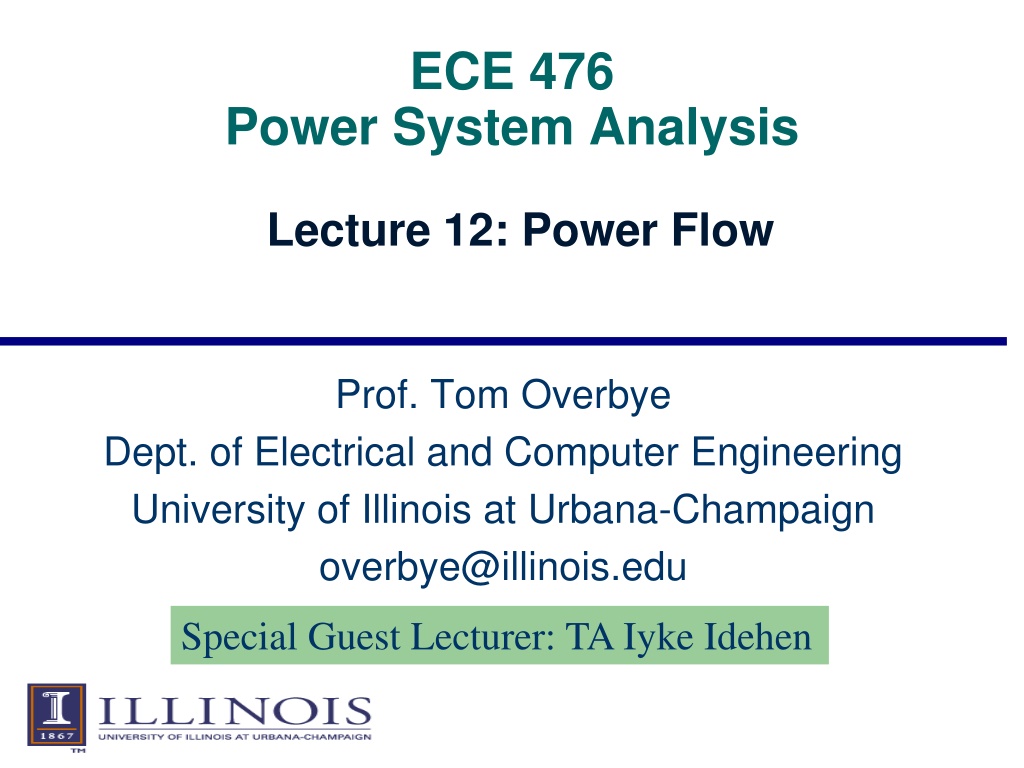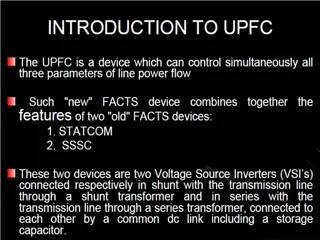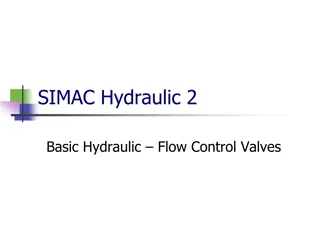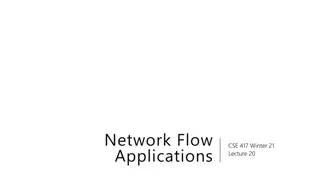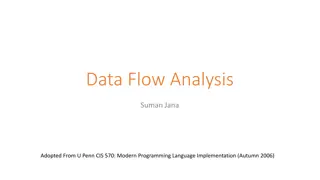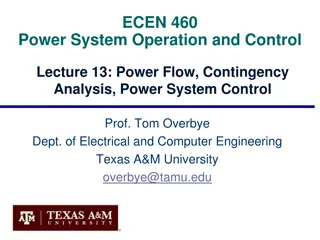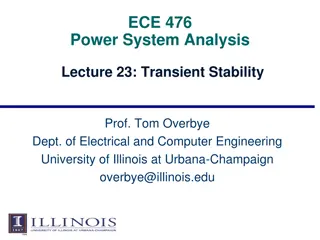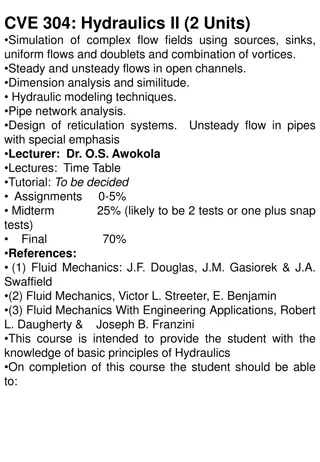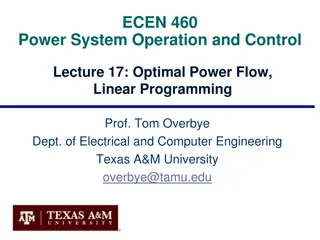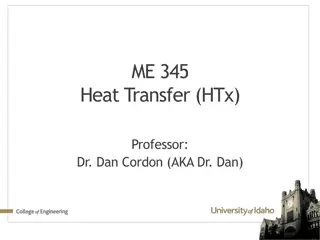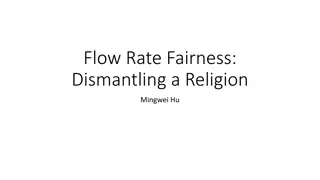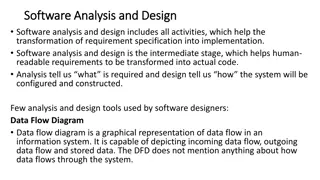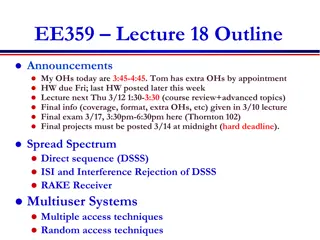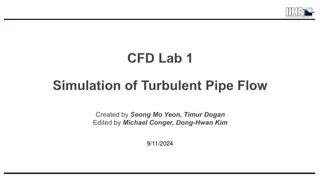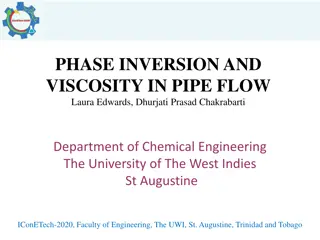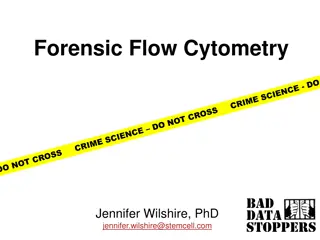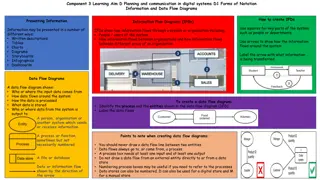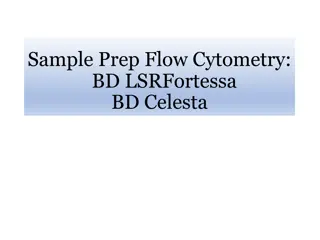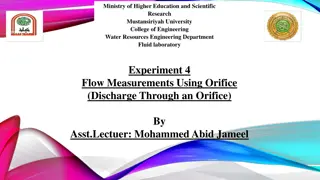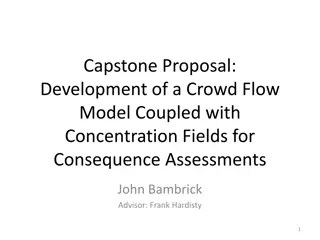Power System Analysis: Lecture on Power Flow
Lecture 12 on Power Flow Analysis in Power Systems covers the use of power balance equations when analyzing complex power consumption and generation. It explains the derivation of real power balance equations for iterative solutions in power flow analysis. The lecture highlights the need for iterative approaches to solve for bus voltages.
Download Presentation

Please find below an Image/Link to download the presentation.
The content on the website is provided AS IS for your information and personal use only. It may not be sold, licensed, or shared on other websites without obtaining consent from the author. Download presentation by click this link. If you encounter any issues during the download, it is possible that the publisher has removed the file from their server.
E N D
Presentation Transcript
ECE 476 Power System Analysis Lecture 12: Power Flow Prof. Tom Overbye Dept. of Electrical and Computer Engineering University of Illinois at Urbana-Champaign overbye@illinois.edu Special Guest Lecturer: TA Iyke Idehen
Announcements Please read Chapter 2.4, Chapter 6 up to 6.6 HW 5 is 5.31, 5.43, 3.4, 3.10, 3.14, 3.19, 3.23, 3.60, 6.30 should be done before exam 1 Exam 1 is Thursday Oct 6 in class Closed book, closed notes, but you may bring one 8.5 by 11 inch note sheet and standard calculators Last name A-M here, N to Z in ECEB 1013 1
Power Flow Analysis When analyzing power systems we know neither the complex bus voltages nor the complex current injections Rather, we know the complex power being consumed by the load, and the power being injected by the generators plus their voltage magnitudes Therefore we can not directly use the Ybus equations, but rather must use the power balance equations 2
Power Balance Equations From KCL we know at each bus i in an n bus system the current injection, , must be equal to the current that flows into the network I i n = = I I I I i Gi Di ik = 1 k I Y V Since = we also know bus n = = I I I ik k Y V i Gi Di = 1 k * = The network power injection is then S V I i i i 3
Power Balance Equations, contd * n n * * * = = = S V I V ik k Y V V ik k Y V i i i i i = = 1 1 k k This is an equation with complex numbers. Sometimes we would like an equivalent set of real power equations. These can be derived by defining Y G jB + ik ik ik j = V V e V i i i i i ik i k j = + Recall e cos sin j 4
Real Power Balance Equations n n j * * = + = = S ( ) P jQ V ik k Y V V V e G jB ik i i i i i k ik ik = = 1 1 k k n = + (cos sin )( ) V V j G jB i k ik ik ik ik = 1 k Resolving into the real and imaginary parts n = + = P ( cos sin ) V V G B P P i i k ik ik ik ik Gi Di = 1 k n = = Q ( sin cos ) V V G B Q Q i i k ik ik ik i k Gi Di = 1 k 5
Power Flow Requires Iterative Solution In the power flow we assume we know S and the . We would like to solve for the V's. The problem is the below equation has no closed form solution: i Y bus * n n * * * = = = S V I V ik k Y V V ik k Y V i i i i i = = 1 1 k k Rath er, we must pursue an iterative approach. 6
Gauss Iteration There are a number of different iterative methods we can use. We'll consider two: Gauss and Newton. With the Gauss method we need to rewrite our equation in an implicit form: x = h(x) (0) To iterate we fir st make an initial guess of x, x , ( +1) v ( ) v = and then iteratively solve x find a "fixed point", x, such that x ( ) until we (x). h x = h 7
Gauss Iteration Example = Example: Solve - 1 0 x x + ( 1) ( ) v v = + 1 x x (0) = Let = 0 and arbitrarily guess x v 1 and solve ( ) v ( ) v v x v x 0 1 2 3 4 1 2 2.41421 2.55538 2.59805 5 6 7 8 9 2.61185 2.61612 2.61744 2.61785 2.61798 8
Stopping Criteria A key problem to address is when to stop the iteration. With the Guass iteration we stop when + ( ) v ( ) v ( 1) ( ) v v with x x x x If x is a scalar this is clear, but if x is a vector we need to generalize t he absolute value by using a norm ( ) v x j Two common norms are the Euclidean & infinity n 2 i = = x x max x x i i 2 = 1 i 9
Gauss Power Flow We first need to put the equation in the correct form * n n * * * = = = S V I V ik k Y V V ik k Y V i i i i i = = 1 1 k n k n * i * * i * i = = = S V I V ik k Y V V ik k Y V i i = = 1 1 k k * i n n S V = = + ik k Y V ii i Y V ik k Y V * i = = k i 1 1, k k * i n S V 1 = V ik k Y V i * i Y = k i ii 1, k 10
Gauss Two Bus Power Flow Example A 100 MW, 50 Mvar load is connected to a generator through a line with z = 0.02 + j0.06 p.u. and line charging of 5 Mvar on each end (100 MVA base). Also, there is a 25 Mvar capacitor at bus 2. If the generator voltage is 1.0 p.u., what is V2? SLoad = 1.0 + j0.5 p.u. 11
Gauss Two Bus Example, contd The unknown is the complex load voltage, V . To determine V we need to know the 1 5 0.02 0.06 5 14.95 Hence 5 15 (Note - 15 0.05 B j j = + 2 Y . 2 bus = 15 j + j + 5 15 j j = Y bus + 5 + 14.70 0.25) j j j 22 12
Gauss Two Bus Example, contd * 2 * 2 n 1 S V = V ik k Y V 2 Y = k i 22 1, k + 1 14.70 j -1 0.5 j = + ( 5 15)(1.0 0) j V 2 * 2 5 V (0) 2 = 1.0 0 (this is known as a flat start) Guess V ( ) 2 ( ) 2 v v v V v V + 0 1 2 1.000 0.9671 0 .9624 0.000 0.0568 j 0.0553 j 3 4 0.9622 0.9622 0.0556 0.0556 j j j 13
Gauss Two Bus Example, contd = = 0.9622 0.0556 0.9638 3.3 V j 2 Once the voltages are known all other values can be determined, such as the generator powers and the line flows * 1 * = + = , Q S In actual units P ( ) 1.023 102.3 MW 0.239 = V Y V 12 2 Y V = j 1 11 1 23.9 Mvar 1 1 25 2 = The capacitor is supplying V 23.2 Mvar 2 14
Slack Bus In previous example we specified S2 and V1 and then solved for S1 and V2. We can not arbitrarily specify S at all buses because total generation must equal total load + total losses We also need an angle reference bus. To solve these problems we define one bus as the "slack" bus. This bus has a fixed voltage magnitude and angle, and a varying real/reactive power injection. 15
Stated Another Way From exam problem 4.c we had Bus 2 Bus 1 j0.2 15 5 10 5 15 10 10 10 20 = Y j bus j0.1 j0.1 Bus 3 This Ybus is actually singular! So we cannot solve This means (as you might expect), we cannot independently specify all the current injections I 1 = V Y I bus 16
Gauss with Many Bus Systems With multiple bus systems we could calculate new V ' as follows: i s = = * i v n S 1 + ( ) v ( 1) v V ik k Y V i ( )* i v Y V = k i ii 1, k ( ) 1 ( ) 2 ( ) v n V v ( , ,..., ) h V V V i + ( 1) v But after we've determined estimate of its voltage , so it makes sense to use this new value. This approach is known as the Gauss-Seidel iteration. we have a better i 17
Gauss-Seidel Iteration Immediately use the new voltage estimates: + = ( 1) ( ) 2 ( 2 ( 2 ( ) 3 , V ( ) v n V v v v ( , , , , ) V h V V V V 2 1 2 + + ( 1) 1) ( ) 3 ( 3 ( ) v n v v v v = ( , , , ) V h V V 2 1 3 + + + ( 1) 1) 1) ( ) 4 ( ) v n v v v = ( , , , , ) V h V V V V V 2 1 4 + + + + ( 1) ( 1) ( 1) ( 1) ( ) v n v v v v = ( , , , , ) V h V V V V V 2 1 n 2 3 4 The Gauss-Seidel works better than the Gauss, and is actually easier to implement. It is used instead of Gauss. 18
Three Types of Power Flow Buses There are three main types of power flow buses Load (PQ) at which P/Q are fixed; iteration solves for voltage magnitude and angle. Slack at which the voltage magnitude and angle are fixed; iteration solves for P/Q injections Generator (PV) at which P and |V| are fixed; iteration solves for voltage angle and Q injection special coding is needed to include PV buses in the Gauss-Seidel iteration (covered in book, but not in slides since Gauss-Seidel is no longer commonly used) 19
Accelerated G-S Convergence Previously in the Gauss-Seidel method we were calculating each value x as + = ( 1) ( ) v v ( ) x h x To accelerate convergence we can rewrite this as + = + ( 1) ( ) v ( ) v ( ) v v ( ) x x h x x Now introduce acceleration parameter + 1) ( ) v x ( ( ) v ( ) v v = + ( ( h x ) ) x x With = 1 this is identical to standard gauss-seidel. Larger values of may result in faster convergence. 20
Accelerated Convergence, contd 1 0 = Consider the previous example: - x x + ( 1) ( ) v ( ) v ( ) v v = + + (1 ) x x x x Comparison of results with different values of 1 0 1 1 1 2 2.20 2 2.4142 2.5399 3 2.5554 2.6045 4 2.59 81 2.6157 5 2.6118 2.6176 = = = = 1.2 1.5 2 k 1 2.5 2.6217 2.6179 2.6180 2.6180 1 3 2.464 2.675 2.596 2.626 21
Gauss-Seidel Advantages/Disadvantages Advantages Each iteration is relatively fast (computational order is proportional to number of branches + number of buses in the system Relatively easy to program Disadvantages Tends to converge relatively slowly, although this can be improved with acceleration Has tendency to miss solutions, particularly on large systems Tends to diverge on cases with negative branch reactances (common with compensated lines) Need to program using complex numbers 22
Newton-Raphson Algorithm The second major power flow solution method is the Newton-Raphson algorithm Key idea behind Newton-Raphson is to use sequential linearization General form of problem: Find an x such that ( ) 0 f x = 23
Newton-Raphson Method (scalar) ( ) v 1. For each guess of , , define x x ( ) v ( ) v = - x x x 2. Represent ( ) by a Taylor series about ( ) f x f x ( ) v ( dx ) df x ( ) v ( ) v = + + ( ) f x ( ) f x x 2 ( ) v ( ) 1 2 ( ) d f x dx 2 ( ) v + + higher order terms x 2 24
Newton-Raphson Method, contd 3. Approximate ( ) by neglecting all terms except the first two f x ( ) v ( dx ) df x ( ) v ( ) v = + ( ) f x 0 ( ) f x x ( ) v 4. Use this linear approximation to solve for x 1 ( ) v ( dx ) df x ( ) v ( ) v = ( ) x f x 5. Solve for a new estim + = ate of x ( 1) ( ) v ( ) v v + x x x 25
Newton-Raphson Example 2 = = Use Newton-Raphson to solve ( ) The equation we must iteratively solve is -2 0 f x x 1 ( ) v ( dx ) df x ( ) v ( ) v = ( ) x f x 1 x + ( ) v ( ) 2 v = (( ) -2) x x ( ) v 2 + ( 1) ( ) v ( ) v v = x x x 1 x + ( 1) ( ) v ( ) 2 v v = (( ) -2) x x x ( ) v 2 26
Newton-Raphson Example, contd 1 x + ( 1) ( ) v ( ) 2 v v = (( ) -2) x x x ( ) v 2 (0) = Guess x 1. Iteratively solving we get ( ) v ( ) v ( ) v v 0 1 ( 1 ) x f x x 1 1.5 0.5 0.08333 0.25 3 3 2.454 10 2 1.41667 6.953 10 6 3 1.41422 6.024 10 27
Sequential Linear Approximations At each iteration the N-R method uses a linear approximation to determine the next value for x Function is f(x) = x2 - 2 = 0. Solutions are points where f(x) intersects f(x) = 0 axis 28
Newton-Raphson Comments When close to the solution the error decreases quite quickly -- method has quadratic convergence f(x(v)) is known as the mismatch, which we would like to drive to zero Stopping criteria is when f(x(v)) < Results are dependent upon the initial guess. What if we had guessed x(0) = 0, or x (0) = -1? A solution s region of attraction (ROA) is the set of initial guesses that converge to the particular solution. The ROA is often hard to determine 29
